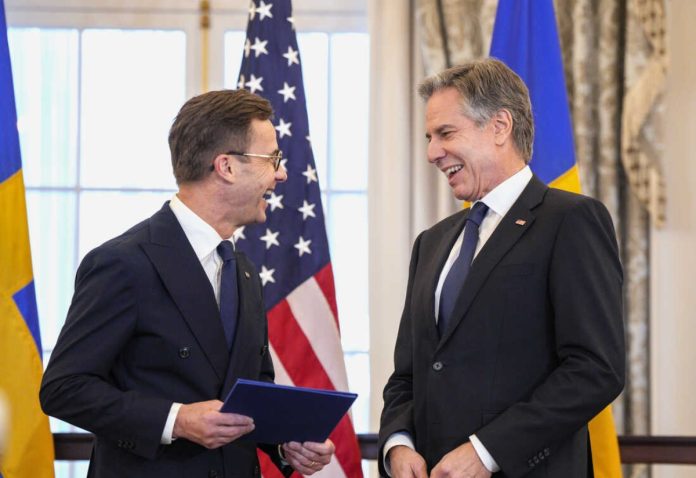On March 11, Sweden’s flag was raised at the North Atlantic Treaty Organization (NATO) headquarters in Brussels. It officially joined the organization on March 7, 2024, becoming the Alliance’s 32nd member – two years after having applied to join. Secretary-General Jens Stoltenberg described it as a “historic day”: “After over 200 years of non-alignment, Sweden now enjoys the protection granted under Article 5, the ultimate guarantee of Allies’ freedom and security.” The Swedish Prime Minister Ulf Kristersson in turn said: “Sweden has come home.” Not everyone is joyful about this event, though.
Sweden’s accession to the Atlantic Alliance does mark the end of any neutrality in the Baltic Sea, as Stoltenberg remarked, thus further “encircling” Russia in its maritime entrance. In 2022, US President Joe Biden famously said that his Russian counterpart Vladimir Putin was looking for the “Finlandization of Europe”, but would get the “NATOization” of the continent instead. I wrote before on the militarization of Europe and its perils, and also on how it is making the European bloc more dependent on an American ally which does not allow the continent to develop industrially, but rather hurts European industries by means of aggressive subsidies packages. It is a strange partnership, indeed.
In any case, the further expansion of NATO, with Swedish and Finnish membership, has extendedthe organization’s territorial reach as far out as the Russian eastward Arctic flank (the Bering strait), thereby making Russia the only non-NATO nation in the Arctic. The region has already been a stage for tensions due to its strategic location and geopolitical importance. Norway’s old slogan for its Arctic Policy was “High North, low tension”. Tensions will of course no longer be low in the new Europe.
They started to rise in fact about a year before the current conflict in Ukraine started. In April 2021, as I wrote, a Norwegian electronic warfare aircraft was intercepted by Russia over the Barents Sea near the Arctic, while approaching Russia’s border. In September 2020, the Norwegian, British and American navies conducted joint exercises just 100 miles from the Russian coastline. The same year (in March) US, Norwegian, British and many other NAT0 units were joined by units from Finland and Sweden to conduct exercises in northern Norway simulating a combat scenario of high intensity.
For decades the Arctic had been a region of active international cooperation, and it would better remain this way: ice melting and rising sea levels are a potentially catastrophic global issue that requires international dialogue and cooperation. However the region instead is now increasingly an arena for geopolitical dispute: the so-called Northern Sea Route, thanks to global warming, is becoming an increasingly attractive option. Such opportunities also bring risks: any increase in shipping traffic across the Arctic might mean an increase in the emissions of polluting gasses. Moreover, in a way, part of the Russian natural defense walls are melting – at an alarming rate. This is why Moscow signed the Paris climate change treaty and takes the issue very seriously.
While Russian strategic goals in the Arctic are of a mainly economic nature, the American ones have remarkably military overtones, with the US state of Alaska, for instance, having the highest concentration of fifth generation fighter aircrafts worldwide. More recently, almost unnoticedly, Washington has claimed an enormous portion of the ocean floor, which reaches from the Gulf of Mexico all the way to the Arctic. The bold territorial grab includes also the Bering and the Arctic Sea, where the Russian Federation, as well as other states, also have claims. It is not just about turning the Baltic Sea into a “NATO lake” – the Arctic will increasingly become a hot topic.
Sweden’s Foreign Minister Tobias Billstrom has stated “we already have joint operations and of course, there will be NATO troops operating in Sweden. The only thing we have said that we don’t want to have is permanent bases. In peacetime, we don’t see any reason to have nuclear weapons on our territory.” It remains to be seen how much pressure Washington will exert in that regard, giving its goals pertaining to a nuclearized Europe.
As Jagannath Panda, head of Stockholm Centre for South Asian and Indo-Pacific Affairs (SCSA-IP) and Mahima Duggal (associated research fellow at the SCSA-IP) point it out at their recent The Diplomat piece, American policy involves bringing NATO “in some form” to the so-called Indo-Pacific region – the “eastward expansion” is all about it. Sweden traditionally acted as a neutral mediator, but now will be expected to “add weight to NATO’s current strategy of building stronger inroads in the Indo-Pacific through security partnerships.” The US policy pertaining to the Indo-Pacific has been mostly about “countering” China and it has been alienating potential allies in the Pacific.
To sum it up, Sweden’s accession to NATO, and all that it entails, actually fosters a vicious cycle of raising military tensions. Rather than being a “win” for the Western bloc, it will bring instability to European security, with global implications. The world is a less secure place now.




